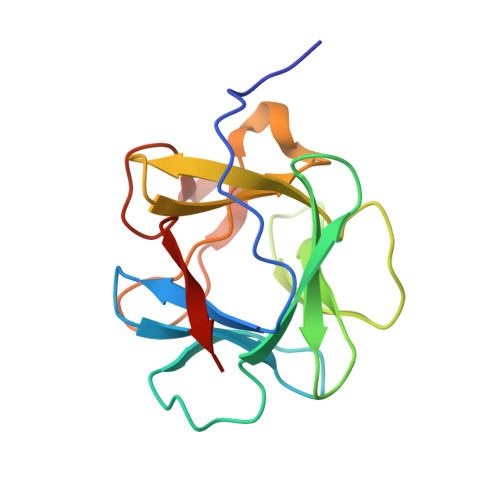Spackling the Crack: Stabilizing Human Fibroblast Growth Factor-1 by Targeting the N and C terminus beta-Strand Interactions
Dubey, V.K., Lee, J., Somasundaram, T., Blaber, S., Blaber, M.(2007) J Mol Biol 371: 256-268
- PubMed: 17570396
- DOI: https://doi.org/10.1016/j.jmb.2007.05.065
- Primary Citation of Related Structures:
2HW9, 2HWA, 2HWM, 2HZ9, 2NTD - PubMed Abstract:
The beta-trefoil protein human fibroblast growth factor-1 (FGF-1) is made up of a six-stranded antiparallel beta-barrel closed off on one end by three beta-hairpins, thus exhibiting a 3-fold axis of structural symmetry. The N and C terminus beta-strands hydrogen bond to each other and their interaction is postulated from both NMR and X-ray structure data to be important in folding and stability. Specific mutations within the adjacent N and C terminus beta-strands of FGF-1 are shown to provide a substantial increase in stability. This increase is largely correlated with an increased folding rate constant, and with a smaller but significant decrease in the unfolding rate constant. A series of stabilizing mutations are subsequently combined and result in a doubling of the DeltaG value of unfolding. When taken in the context of previous studies of stabilizing mutations, the results indicate that although FGF-1 is known for generally poor thermal stability, the beta-trefoil architecture appears capable of substantial thermal stability. Targeting stabilizing mutations within the N and C terminus beta-strand interactions of a beta-barrel architecture may be a generally useful approach to increase protein stability. Such stabilized mutations of FGF-1 are shown to exhibit significant increases in effective mitogenic potency, and may prove useful as "second generation" forms of FGF-1 for application in angiogenic therapy.
Organizational Affiliation:
Department of Biomedical Sciences, Florida State University, Tallahassee FL 32306, USA.















